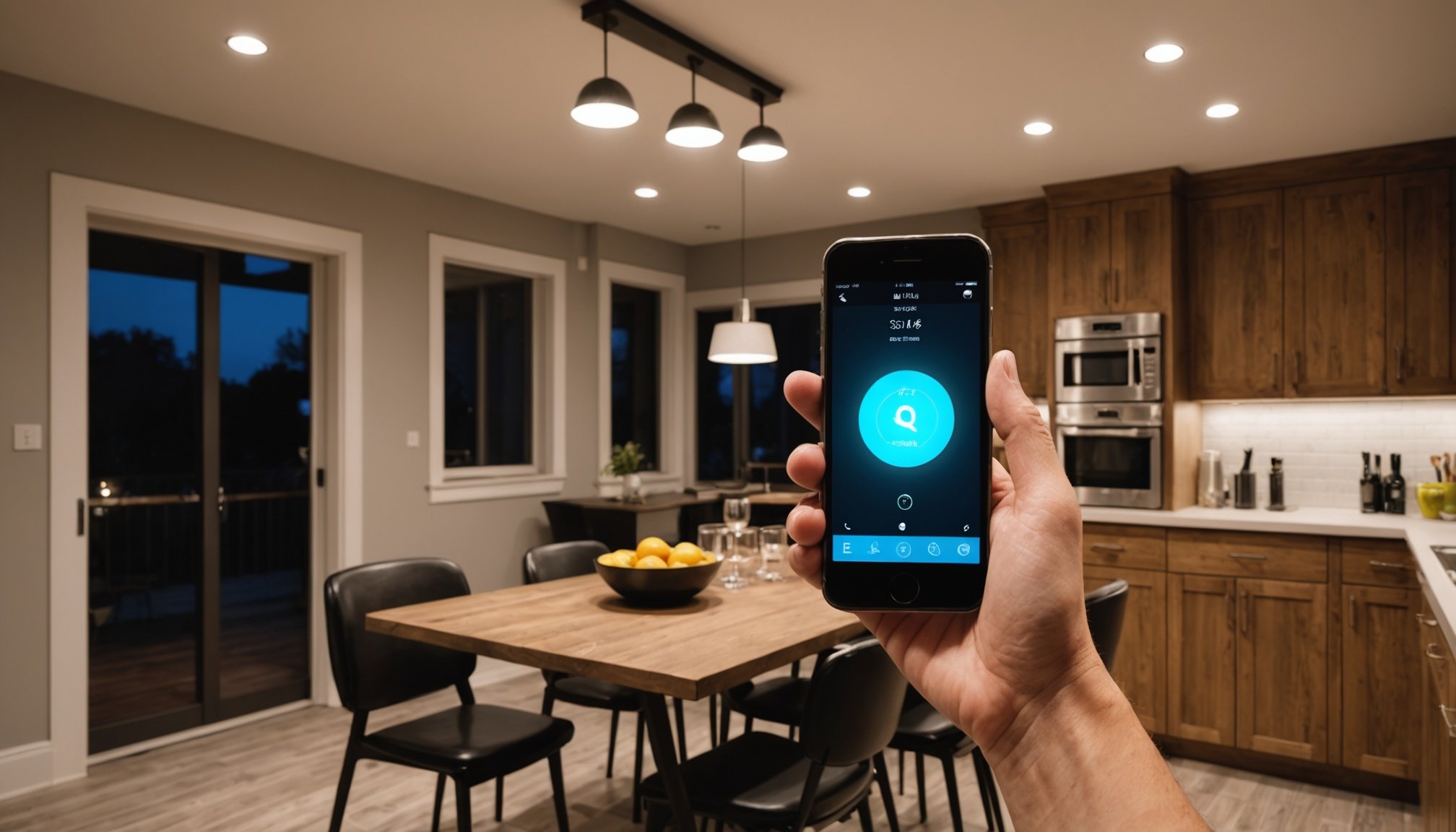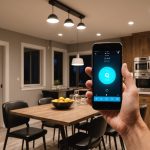Ready to reshape your home with modern technology? A smart lighting system can enhance ambiance, improve energy efficiency, and elevate security, all from the convenience of your smartphone. This step-by-step guide will walk you through the installation process and help you customize your lighting experience. Whether you seek a cozy atmosphere for movie nights or bright lights for productivity, transforming your home is just a few taps away. Unlock the potential of smart lighting today!
Understanding Smart Lighting Systems
Smart lighting systems have revolutionised home automation, offering a plethora of benefits that extend beyond mere convenience. These systems allow users to control lighting remotely through apps or voice commands, integrating seamlessly with other smart home devices.
This might interest you : Transform Your Living Space: A Step-by-Step Guide to Utilizing Your Smartphone for an Immersive Surround Sound Home Theater Setup
One of the primary advantages of upgrading to smart lighting is the enhancement of energy efficiency. By enabling precise control over lighting schedules and intensity, smart lighting reduces unnecessary energy consumption. This, in turn, leads to significant cost savings on electricity bills. For instance, lights can be programmed to dim or turn off automatically when no one is in the room, ensuring that energy is not wasted.
Additionally, smart lighting systems contribute to a more environmentally friendly home. By optimising energy use, they help reduce the household's carbon footprint. The integration of smart lighting with other home automation systems further enhances its benefits, allowing for a cohesive and efficient home environment.
Also to discover : Mastering Your Smartphone: Effortless Control of Smart Home Air Purifiers for Fresher Indoor Air
In summary, the shift to smart lighting systems not only provides enhanced control and convenience but also promotes energy efficiency and cost-effectiveness. As part of a comprehensive home automation strategy, smart lighting is an essential component for modern, sustainable living.
Selecting the Right Smart Lighting Products
Choosing the right smart lighting products involves understanding the different types available and their key features. Smart bulbs and smart switches are the most common options. Smart bulbs are easy to install as they replace your existing light bulbs and offer features like colour changing and dimming. On the other hand, smart switches replace traditional wall switches, allowing you to control any light fixture connected to them, which is ideal if you want to maintain the use of your existing bulbs.
When selecting smart lighting, consider compatibility with your home systems. Ensure that the smart bulbs or switches you choose can seamlessly integrate with your current home automation setup. Compatibility with platforms like Amazon Alexa, Google Assistant, or Apple HomeKit can enhance your control options, providing a more cohesive smart home experience.
Key features to look for include the ability to schedule lighting, remote access via apps, and energy monitoring. These features not only add convenience but also contribute to energy efficiency, aligning with the benefits of smart lighting systems. By carefully selecting products that match your needs and existing systems, you can maximise the benefits of your smart lighting investment.
Essential Smartphone Apps for Smart Lighting
Smartphone apps play a crucial role in managing and optimising smart lighting systems. These apps offer a range of features designed to enhance the user experience and provide seamless control over your lighting setup.
Overview of Popular Smart Lighting Apps
Several apps have gained popularity for their intuitive interfaces and robust functionalities. Apps from major brands like Philips Hue, LIFX, and Wyze are frequently praised for their reliability and ease of use. Each of these apps is tailored to work with specific smart lighting products, ensuring compatibility and smooth operation.
Features That Enhance User Experience
Key features that enhance the user experience include scheduling, remote access, and energy monitoring. Scheduling allows users to automate lighting based on daily routines, while remote access lets you control lights from anywhere. Energy monitoring helps track usage, promoting energy efficiency.
Comparison of App Functionalities
When comparing smart lighting apps, consider the unique functionalities each offers. For instance, some apps provide advanced scene settings, allowing users to create custom lighting environments. Others may offer integration with voice assistants or support for multiple users, making it easier to share control within a household. By evaluating these features, you can select an app that aligns with your needs and enhances your smart lighting experience.
Step-by-Step Installation Process
Installing a smart lighting system can be straightforward with the right preparation and guidance. This process involves a few key steps to ensure a smooth transition.
Pre-Installation Preparations and Tools Needed
Before beginning, gather essential tools such as a screwdriver, wire strippers, and a voltage tester. Ensure you have your smart lighting installation kit ready, which typically includes bulbs, switches, and a setup guide. Safety first: turn off power at the circuit breaker to avoid electric shocks.
Detailed Installation Steps for Smart Bulbs and Switches
For smart bulbs, the process is simple: remove your old bulb and screw in the new smart bulb. Follow the manufacturer's setup guide to connect it to your home Wi-Fi network through the dedicated app.
Installing smart switches is more involved. Begin by removing the existing switch cover and unscrewing the switch from the wall. Use the wiring instructions in the setup guide to connect the smart switch, ensuring wires are securely fastened. Replace the switch cover once everything is connected.
Common Installation Challenges and Solutions
A frequent issue is incorrect wiring. Double-check connections using the setup guide, and ensure wires are matched correctly. If the smart device fails to connect to Wi-Fi, verify network settings and proximity to the router.
Configuring Your Smart Lighting System
Configuring your smart lighting system begins with the initial setup via smartphone apps. After installation, open the app associated with your smart lighting products. Follow the in-app instructions to connect your lights to your home network. This process often involves scanning a QR code or entering a unique code to ensure secure connection.
Customizing Lighting Settings and Schedules
Once connected, you can tailor the app settings to suit your user preferences. Most apps allow you to adjust brightness, colour, and temperature to create the desired ambiance. Scheduling is another powerful feature. You can set your lights to turn on or off at specific times, aligning with your daily routine. This not only enhances convenience but also contributes to energy efficiency.
Integrating with Other Smart Home Devices
Integration with other smart home devices can elevate your smart lighting configuration. Many systems are compatible with platforms like Amazon Alexa or Google Assistant, enabling voice control. You can also sync your lights with other devices, such as smart thermostats or security systems, for a cohesive home automation experience. This integration allows for scenarios like lights turning on when a security camera detects motion, enhancing both convenience and security.
Troubleshooting Common Smart Lighting Issues
Smart lighting systems, while innovative, can occasionally present challenges. Effective smart lighting troubleshooting can ensure your system functions seamlessly.
Connectivity Issues
Connectivity is a frequent concern. If your lights aren't responding, first check your Wi-Fi connection. Ensure your router is within range and functioning properly. Restarting both the router and the smart lighting device can often resolve issues. If the problem persists, verify that your device firmware is up-to-date, as updates can fix bugs and improve performance.
App Control Problems
Problems with app control are another common issue. If your app isn't recognising your lights, confirm that both your smartphone and the app are updated to the latest versions. Clear the app cache to remove any temporary glitches. Reinstalling the app can also help re-establish a stable connection between your device and the smart lighting system.
Performance Inconsistencies
Performance inconsistencies, such as lights flickering or not reaching full brightness, can be frustrating. These issues may stem from electrical problems or incompatible bulbs. Ensure that your bulbs are compatible with your smart switches and that they are securely installed. If flickering persists, consult an electrician to check for wiring issues.
Maximizing Benefits of Your Smart Lighting System
To fully harness smart lighting benefits, consider strategies for energy management and lifestyle enhancement. Smart lighting can significantly reduce energy consumption. Use scheduling features to ensure lights are only on when needed. For instance, set lights to turn off automatically during daylight hours or when no one is home, maximising energy savings.
Enhancing your home's ambiance is another key benefit. Smart lighting allows you to adjust brightness and colour, creating the perfect mood for any occasion. Whether you're hosting a dinner party or winding down for the evening, tailor the lighting to suit your needs. Experiment with different settings to discover what works best for your space.
Automation features in smart lighting systems offer daily convenience. Integrate your lights with other smart home devices for a seamless experience. For example, set your lights to gradually brighten as your morning alarm goes off, providing a gentle wake-up. Or, connect your lighting with motion sensors, so lights automatically illuminate when you enter a room.
By exploring these features, you can enhance both the functionality and enjoyment of your smart lighting system, making it an integral part of your daily routine.











